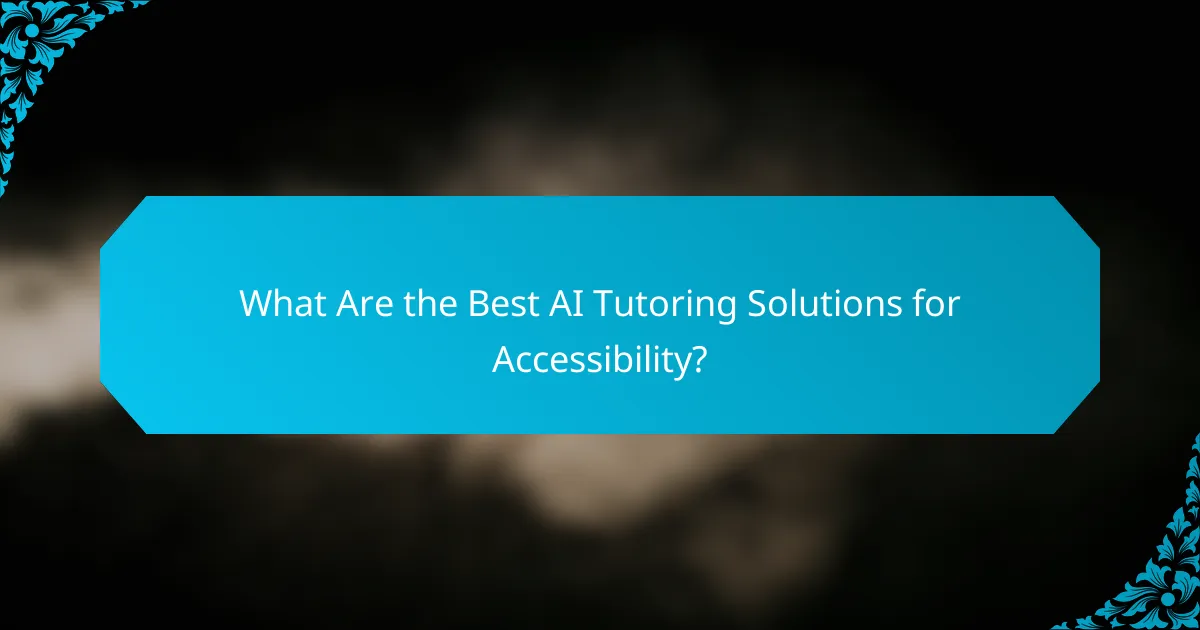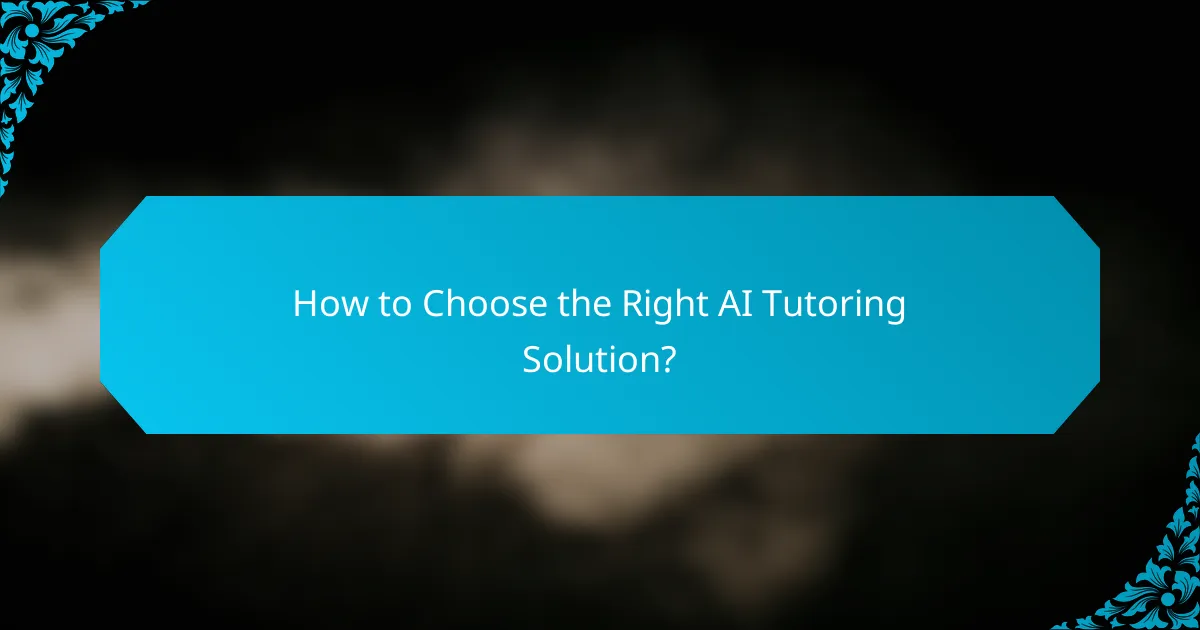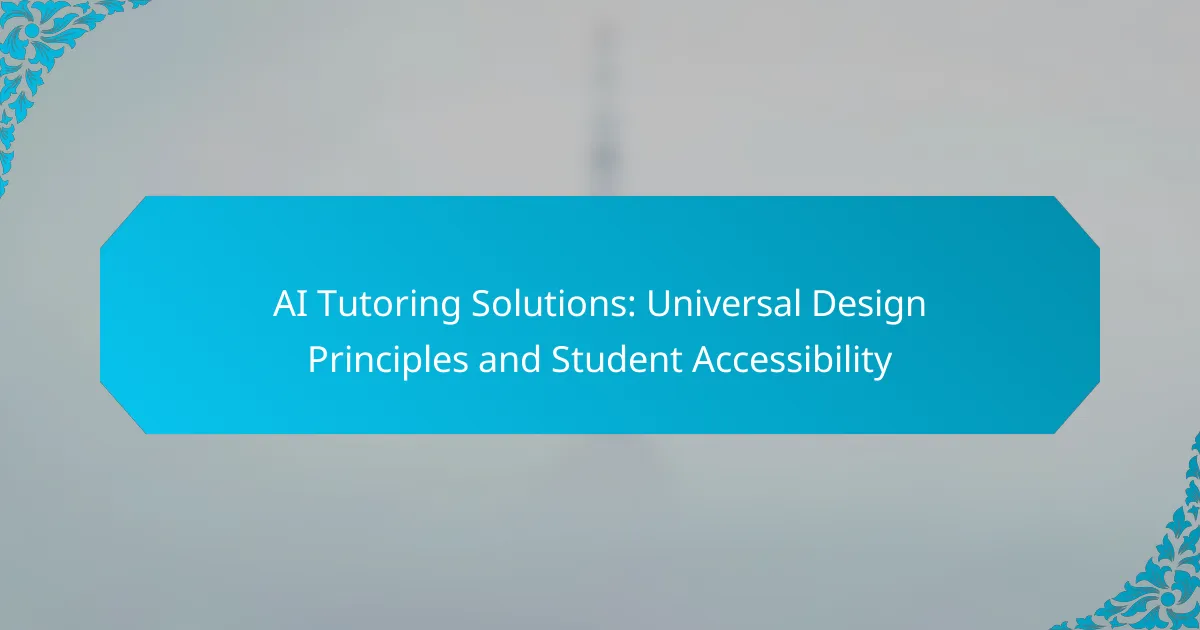AI tutoring solutions are revolutionizing education by prioritizing accessibility through personalized learning experiences tailored to diverse student needs. By employing adaptive learning technologies and universal design principles, these platforms ensure that all students, including those with disabilities, can effectively engage with educational content and overcome barriers to learning.

What Are the Best AI Tutoring Solutions for Accessibility?
The best AI tutoring solutions for accessibility focus on providing personalized learning experiences that cater to diverse student needs. These platforms utilize adaptive learning technologies to ensure that all students, including those with disabilities, can engage effectively with educational content.
Google Classroom
Google Classroom is a widely used platform that integrates various tools to enhance accessibility for students. It allows educators to create and distribute assignments while providing features like screen reader compatibility and captioning for videos.
Teachers can customize their content to meet individual student needs, making it easier for learners with different abilities to access materials. The platform also supports various file formats, ensuring that resources are available in accessible ways.
IBM Watson Tutor
IBM Watson Tutor employs artificial intelligence to offer personalized tutoring experiences tailored to each student’s learning style. It can analyze student performance in real-time and adjust the difficulty of tasks accordingly.
This adaptability is crucial for accessibility, as it allows students with varying abilities to progress at their own pace. Additionally, the platform can provide feedback and resources in multiple formats, accommodating different learning preferences.
Carnegie Learning MATHia
Carnegie Learning MATHia is designed specifically for math education and incorporates AI to provide personalized feedback and support. Its interactive interface is user-friendly and includes features that assist students with disabilities, such as audio instructions and visual aids.
The program adapts to each student’s learning journey, offering hints and step-by-step guidance, which is particularly beneficial for those who may struggle with traditional teaching methods.
DreamBox Learning
DreamBox Learning focuses on K-8 math education and utilizes adaptive learning technology to cater to diverse student needs. The platform adjusts in real-time to student responses, ensuring that learners receive appropriate challenges and support.
Accessibility features include audio support and visual representations of mathematical concepts, making it easier for students with different learning abilities to grasp complex ideas. This adaptability enhances overall engagement and retention.
Smart Sparrow
Smart Sparrow offers a platform for creating adaptive learning experiences across various subjects. Educators can design interactive lessons that respond to student inputs, providing personalized pathways through the material.
Its accessibility features include customizable content that can be tailored for students with disabilities, ensuring that all learners can participate fully. The platform’s analytics tools also help educators monitor progress and adjust instruction as needed.

How Do AI Tutoring Solutions Enhance Student Accessibility?
AI tutoring solutions significantly enhance student accessibility by providing tailored educational experiences that cater to individual learning needs. These tools leverage technology to break down barriers, ensuring that all students, regardless of their backgrounds or abilities, can engage with educational content effectively.
Personalized Learning Paths
Personalized learning paths allow students to progress at their own pace, adapting to their unique strengths and weaknesses. AI systems analyze a learner’s performance and preferences, creating a customized curriculum that targets specific areas for improvement. For instance, a student struggling with algebra may receive additional resources and practice problems tailored to their level.
When implementing personalized learning paths, it’s crucial to regularly assess student progress and adjust the learning materials accordingly. This iterative approach helps maintain engagement and ensures that students are continually challenged without feeling overwhelmed.
Real-time Feedback Mechanisms
Real-time feedback mechanisms provide immediate responses to student inputs, facilitating a more interactive learning experience. These systems can highlight mistakes, suggest corrections, and offer explanations instantly, which helps reinforce learning concepts. For example, if a student answers a math problem incorrectly, the AI can provide hints or step-by-step solutions right away.
To maximize the effectiveness of real-time feedback, ensure that the AI tutoring solution is designed to be user-friendly and intuitive. Students should feel comfortable interacting with the system, as this will encourage them to seek help when needed and foster a growth mindset.
Multimodal Learning Resources
Multimodal learning resources encompass various formats, such as videos, interactive simulations, and text-based materials, catering to diverse learning styles. By integrating different types of content, AI tutoring solutions can engage auditory, visual, and kinesthetic learners effectively. For instance, a science lesson might include a video demonstration, a hands-on experiment, and a written summary to reinforce the topic.
When selecting multimodal resources, consider the specific needs of your students and the subject matter. Offering a variety of formats not only enhances understanding but also keeps students motivated and interested in their learning journey.

What Universal Design Principles Apply to AI Tutoring?
Universal design principles for AI tutoring focus on creating accessible and effective learning experiences for all students. These principles ensure that educational tools accommodate diverse needs and preferences, enhancing engagement and learning outcomes.
Equitable Use
Equitable use means that AI tutoring solutions should be beneficial for all students, regardless of their backgrounds or abilities. This principle emphasizes the importance of providing equal access to learning resources and opportunities, ensuring that no group is disadvantaged.
For instance, an AI tutoring platform should offer content in multiple languages and formats, catering to students with different linguistic skills and learning preferences. Additionally, it should include features like text-to-speech for visually impaired users, promoting inclusivity.
Flexibility in Use
Flexibility in use allows students to engage with AI tutoring solutions in ways that suit their individual learning styles. This principle encourages the incorporation of various methods for interaction, such as voice commands, touch inputs, or keyboard shortcuts.
AI tutoring systems can enhance flexibility by allowing students to choose their preferred pace and learning pathways. For example, a student might opt for a quick review of concepts or a more in-depth exploration based on their comfort level and understanding.
Simplicity and Intuitiveness
Simplicity and intuitiveness in AI tutoring tools ensure that students can easily navigate and utilize the platform without confusion. A straightforward design minimizes cognitive load, allowing learners to focus on content rather than struggling with complex interfaces.
To achieve this, AI tutoring solutions should feature clear instructions, logical layouts, and consistent terminology. For example, using familiar icons and straightforward navigation menus can help students quickly find the resources they need, enhancing their overall learning experience.

How to Choose the Right AI Tutoring Solution?
Selecting the right AI tutoring solution involves understanding the specific needs of students, evaluating usability features, and comparing pricing models. A well-chosen solution can enhance learning experiences and accessibility for diverse learners.
Assessing Student Needs
Begin by identifying the unique requirements of your students. Consider factors such as learning styles, subject areas, and any special accommodations needed for disabilities. Gathering feedback from students and educators can provide valuable insights into what features are essential.
Utilize surveys or interviews to collect data on student preferences and challenges. This information will guide you in selecting an AI tutoring solution that effectively addresses these needs, ensuring a more personalized learning experience.
Evaluating Usability Features
Usability is crucial in AI tutoring solutions, as it directly impacts student engagement and learning outcomes. Look for features like intuitive interfaces, accessibility options, and responsive design that cater to various devices. A user-friendly platform encourages students to interact more effectively with the content.
Consider tools that offer real-time feedback, adaptive learning paths, and interactive elements. These features can significantly enhance the learning process by providing immediate support and adjusting to individual progress.
Comparing Pricing Models
Pricing models for AI tutoring solutions can vary widely, from subscription-based services to one-time payments. Assess the total cost of ownership, including any hidden fees for additional features or support. Many platforms offer tiered pricing, which can be beneficial for different budgets.
Evaluate what each pricing tier includes and whether it aligns with your budget and needs. Some solutions may offer free trials or pilot programs, allowing you to test their effectiveness before committing financially. This approach can help avoid costly mistakes and ensure you choose a solution that provides good value.

What Are the Challenges in Implementing AI Tutoring Solutions?
Implementing AI tutoring solutions presents several challenges that can hinder their effectiveness and accessibility. Key issues include data privacy concerns, integration with existing educational systems, and the need for adequate training for educators.
Data Privacy Concerns
Data privacy is a significant challenge when deploying AI tutoring solutions, as these systems often require access to sensitive student information. Schools must comply with regulations such as FERPA in the United States or GDPR in Europe, which mandate strict guidelines on data handling and student consent.
To address these concerns, institutions should prioritize transparency in data usage and implement robust security measures. Regular audits and clear communication with students and parents about data practices can help build trust and ensure compliance.
Integration with Existing Systems
Integrating AI tutoring solutions with current educational systems can be complex and resource-intensive. Schools often use various platforms for learning management, grading, and communication, and ensuring compatibility can require significant technical expertise.
To facilitate smoother integration, schools should conduct thorough assessments of their existing systems and choose AI solutions that offer flexible APIs or built-in compatibility features. Collaborating with IT professionals during the implementation phase can also help mitigate potential disruptions.
Training for Educators
Effective use of AI tutoring solutions hinges on proper training for educators. Teachers need to understand how to incorporate these tools into their teaching methods and how to interpret the data generated by AI systems.
Providing comprehensive training programs that include hands-on workshops and ongoing support can enhance educators’ confidence and competence. Schools should also encourage a culture of continuous learning, allowing teachers to share best practices and experiences with AI tools.
